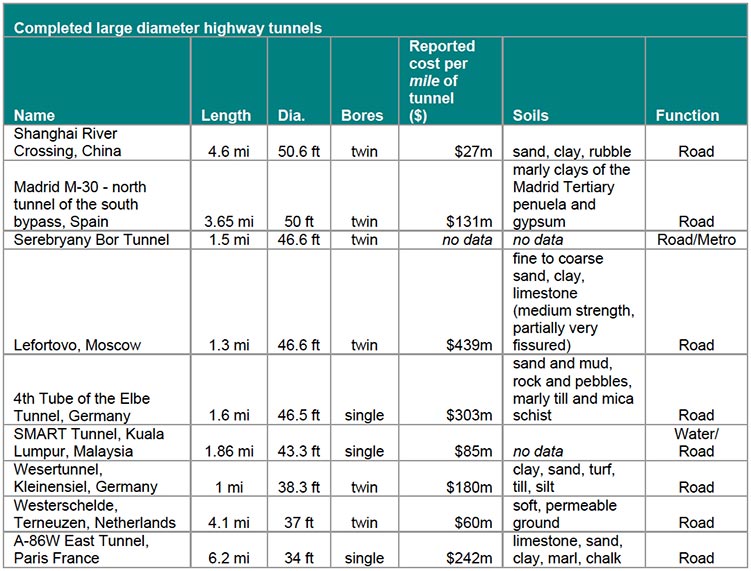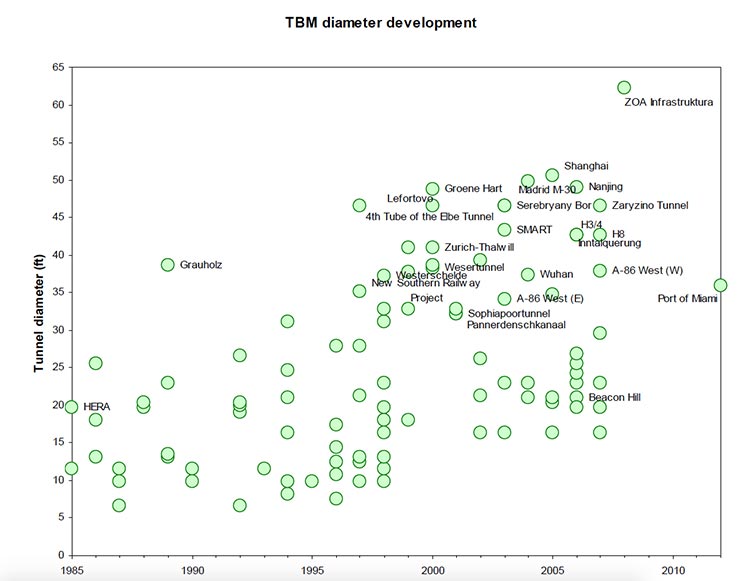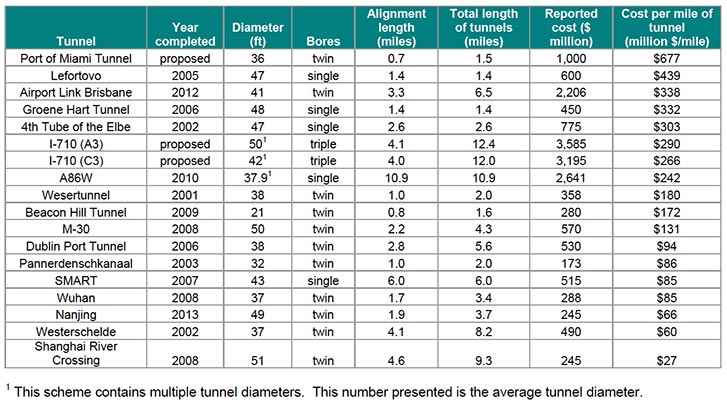Cost benefits of large-diameter bored tunnels Apr 2015
Bored tunnel technology is continually developing, and larger and more safely constructed tunnels are becoming more common. This additional size allows more versatile configurations within the tunnel to allow stacking of traffic lanes and the combination of different uses, such as highway and transit. While major transportation projects have a wide impact on the surrounding community, tunnels typically provide greater benefits than other alternatives. For these projects, total whole-life costs rather than construction costs alone better reflect overall costs incurred by an owner.
Large Diameter Tunnels
Recent achievements reflect the improvements that have been made in tunnel boring technology over the last few decades and the increases in diameter that have recently been achieved around the world (Fig 1). It is also becoming more commonly used in the US for highway traffic, such as for the Port of Miami tunnels and the proposed I-710 project in Los Angeles.
The successful completion of two highway tunnels beneath the Yangtze River in Shanghai represents another milestone in the development of large-diameter bored tunnel projects around the world. The tunnels, the largest in the world to date at 51ft in diameter, will carry three lanes of vehicular traffic and a transit line in each direction between Pudong in Shanghai and Changxing Island, a distance of 4.7 miles (Fig 2). They were constructed in difficult ground conditions comprising sands and clays under high groundwater pressures some 200ft below ground level. The tunnels were completed in 20 months, and the project is expected to open in 2010, one year ahead of schedule.
This success comes on the back of the completion of the M-30 tunnels in Madrid in 2008. These tunnels, at a diameter of 50ft, form part of a ring road around Madrid carrying three traffic lanes in each direction and were completed four months ahead of schedule. This subsurface project allowed the removal of highways from the banks of the Manzanares River and their development as a public amenity. Additionally, the 1.4km Serebryany Bor tunnel (46ft diameter) in Moscow was opened in 2007, becoming the first tunnel in the world to combine road traffic and metro transit.
Looking to the future, large tunnels will become more commonly used and of larger diameter. On 27 March 2008, Moscow based ZOA Infrastruktura announced a deal to acquire a 62.3ft diameter tunnel boring machine (TBM). It will be used to construct the first bored tunnel capable of accommodating a four-lane highway. Fig 3 shows the increases in tunnel diameters that have been delivered over the last two decades alongside proposals that have been announced for the next five years (see Appendix A for a list of completed, in construction, and proposed large-bore tunnels).
TBM technology
Over the last two decades, the ability of TBMs to construct large-diameter tunnels in weak ground and significant groundwater pressures has increased significantly. Historically, tunnels in these ground conditions were constructed with the use of compressed air to provide support to the ground. Modern TBMs use a pressurized, or closed, face at the front of the machine to maintain stability in the ground while allowing workers to operate in safe conditions within the tunnel.
There are two main types of soft-ground TBMs. An Earth Pressure Balance Machine (EPBM) controls the rate at which the excavated ground is removed through the pressured face so that an appropriate level of support is provided to the ground around the tunnel, maintaining stability. A slurry, or mixshield, TBM uses a bentonite fluid to maintain support and to carry the excavated ground in suspension. The choice between the two types of machine depends on the exact nature of the ground, with EPBMs more suited to clays and silt and slurry machines to sandy ground or gravels. In complex projects with varying ground conditions, a hybrid machine that has the ability to work in both modes can be used.
As a track record of successful tunneling with soft-ground TBMs has been established and more sophisticated control systems have become available, the ability to excavate larger-diameter tunnels in more challenging ground has increased. Some specific areas of improvement that have allowed soft ground tunneling to be carried out with less risk, lower impacts, and greater efficiency include:
- Motors used to rotate the cutting head at the front of the machine have become more powerful and can be controlled much more accurately, allowing larger TBMs that can operate in more complex ground.
- Modern soft-ground TBMs can collect and process a vast amount of data in real time so that the operator has a good understanding of how the machine and the ground around it are performing, allowing a high level of control. This particularly allows very close control of ground movements above the tunnel, permitting the construction of tunnels in dense urban environments without damage to buildings or subsurface utilities.
- Increased scientific understanding of foams and additives that can be added into excavated soil in the pressurized area at the front of the TBM, providing uniform support to the ground around the tunnel.
- Increased understanding of the abrasive effects of the ground on machines, allowing for TBMs to be designed to suffer less wear and an increase in reliability.
- Improved design of cutting tools mounted on the front of the TBM, which provides better performance. Electronic sensors can be incorporated in the cutting tools to detect when the tools are becoming worn, which allows maintenance to be scheduled.
- Large-diameter TBMs have been designed to allow the replacement of cutting tools without sending workers into the pressurized zone in front of the machine, simplifying maintenance procedures.
- Improved design of seals in bearings and between the TBM and the tunnel lining have allowed tunnels to be constructed under higher groundwater pressures.
- Ground penetrating radar has been used on some TBMs to help identify the location of boulders or other obstructions ahead of the tunnel, reducing the risk of unplanned stoppages.
With increases in tunnel diameter, innovative configurations of corridors within the tunnels have been developed to optimize the usage of underground space (Fig 4). These include double-stacked traffic decks, separation of vehicle traffic from heavy goods vehicles, provision of transit corridors through highway tunnels, and, in the case of the SMART tunnel in Malaysia, the use of part - and under some conditions all - of the tunnel as a storm-water overflow tunnel (see Appendix B for more examples).
‘Like-for-like’ cost comparisons
Cost estimating for large infrastructure projects is a complex process impacted by many variables. Cost comparisons of project alternatives in the US are typically carried out on the basis of construction cost only, however it is becoming more widely recognized that the longer term costs to an owner are heavily influenced by the maintenance and operational costs and the eventual replacement costs or residual asset value. This type of analysis is commonplace in the manufacturing industry and is the approach taken by private investors when considering the construction or purchase of an infrastructure facility such as a highway.
While the project cost for a bored tunnel may be slightly more than that of a viaduct and substantially more than a surface street option, when whole-life costs are considered the tunnel becomes the most cost-effective solution1.
Project construction costs
Reported project construction costs for a number of tunnel projects have been compiled from a survey of completed and proposed projects (Fig 5). Data on major infrastructure projects is readily available, but the basis of the estimates is often unclear. It is often difficult to arrive at a realistic cost estimate without some engineering-defined criteria on which to base the costs. Baseline cost data from similar projects around the globe are useful but not always illustrative of the eventual costs of a project that may not contain the same combination of required features.
With the above caveats in mind, Figs 5 and 6 summarize a literature survey of global large-bore tunnel costs. As some projects comprise a single-bore solution and others a twin-bore solution, the data is presented in dollars per tunnel mile. The highlighted projects suggest a typical cost range per mile of a twin-bore project of approximately $200 million to $700 million. Projects at the lower end of the cost scale are often in Asian countries where labor and material costs are significantly lower. Higher costs per mile are reported in western European countries and in the US. This data indicates that construction costs for tunnel projects larger than a 2-mile Alaskan Way by-pass tunnel are somewhat less than previously published estimates for the Alaskan Way Viaduct replacement.
In comparing these costs with estimates produced for the Alaskan Way project, it should be noted that project costs developed by WSDOT use a statistical approach to construction costing that recognizes the various risks that may impact the project cost and applies a differing amount of contingency dependent on the certainty of the cost estimate2. During project development, costs reported for a high level of certainty of non-exceedance may be higher than those determined by more traditional methods.
Whole-life cost estimate
Maintenance and operational costs for a road tunnel are likely to be similar to that of a surface street option and significantly lower than that of an elevated highway3. The maintenance of way costs will be similar, however maintenance and operation of ventilation systems can be an additional cost of longer tunnels, while structural repair costs for viaducts typically increases that of an above ground structure.
The largest whole-life benefit of a tunnel is its longer design life. A tunnel lifespan can approach 150 years, against 50 years for an elevated structure. This is evidenced in Seattle by the BNSF tunnels that are over 100 years old compared to the existing Alaskan Way Viaduct and SR-520 which are reaching the end of their lifespan after approximately 50 years. Given the potential for seismic events in the Pacific Northwest, tunnels perform better in earthquakes as evidenced by the damage caused to the Bay Bridge and the Embarcadero highway in San Francisco against the performance of the BART transit tunnels below the bay, which remained largely unaffected by the Loma Prieta earthquake in 1989.
The importance of whole-life costing is demonstrated by the fact that the ‘conventional’ cost of an infrastructure project could amount to only 26% of the whole-life cost (Fig 7). A full whole-life cost of any infrastructure replacement option is therefore the most appropriate approach to generate a fair and comparable assessment.
Broader benefits
Major infrastructure projects typically have a wider benefit to the community, and as such these benefits should be fully considered in the assessment of options. The benefits of a tunnel option, when compared with above-ground options, include increased property values, reduced congestion and associated pollution, and reduced disruption to businesses, pedestrians, and traffic during construction. Land freed up by placing the facility below ground presents opportunity for improved public amenity and development opportunities particularly at the portal locations. These benefits can be assigned a monetary value that should be included in a detailed assessment.
There are two significant points to consider when examining the impacts of a tunnel versus a surface street or a viaduct3: 1) tunnels have the lowest pro-rate cost taking into account the longer design life of tunnels, and 2) when the cost of environmental pollution, loss of property taxes, social divide, and maintenance cost is taken into account, the annual costs of a typical tunnel is half that of the at-grade option and a third that of an elevated structure.
Author references
- Compiling real costs for true infrastructure construction comparison. T&T North America December 2005.
- Reilly, John. Probable cost estimating and risk management. North American Tunneling 2008 Proceedings.
- Burger, Werner & Gerhard Wehymeyer (Herrenknecht AG). Lifting the lid on mixshield performance. Tunnels and Tunneling International June 2008.
- Herrenknecht, Martin & Karin Bäppler. Tunnel boring machine development. North American Tunneling Conference 2008.
- Herrenknecht, Martin & Karin Bäppler. State of the art in TBM tunneling. North American Tunneling Conference 2006.
- Ishii, G. Current issues regarding mechanized and automated tunneling. Tunnels and Underground Structures 2000.
- Parker, Harvey W. Bold and visionary planning of tunnels and underground space. North American Tunneling 2008 Proceedings.
References
- Tracking the world's mega-TBMs – TunnelTalk, Discussion Forum
- Technical parameters of Seattle's mega EPBM – TunnelTalk, Dec 2012
- Alaskan Way selects construction management – TunnelTalk, Apr 2011
- Proposals called for Seattle's big bore tunnel – TunnelTalk, May 2010
- Alaskan Way bored tunnel agreement – TunnelTalk, Oct 2009
|
|
|
|
|
Add your comment
- Thank you for taking the time to share your thoughts and comments. You share in the wider tunnelling community, so please keep your comments smart and civil. Don't attack other readers personally, and keep your language professional.








